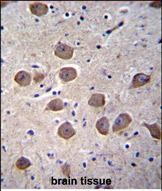CTNND2 Antibody (C-term)
Affinity Purified Rabbit Polyclonal Antibody (Pab)
- SPECIFICATION
- CITATIONS
- PROTOCOLS
- BACKGROUND

Application
| IHC-P, WB, E |
|---|---|
| Primary Accession | Q9UQB3 |
| Other Accession | O35927, NP_001323.1 |
| Reactivity | Human, Mouse |
| Host | Rabbit |
| Clonality | Polyclonal |
| Isotype | Rabbit IgG |
| Calculated MW | 132656 Da |
| Antigen Region | 1131-1159 aa |
| Gene ID | 1501 |
|---|---|
| Other Names | Catenin delta-2, Delta-catenin, GT24, Neural plakophilin-related ARM-repeat protein, NPRAP, Neurojungin, CTNND2, NPRAP |
| Target/Specificity | This CTNND2 antibody is generated from rabbits immunized with a KLH conjugated synthetic peptide between 1131-1159 amino acids from the C-terminal region of human CTNND2. |
| Dilution | IHC-P~~1:10~50 WB~~1:1000 E~~Use at an assay dependent concentration. |
| Format | Purified polyclonal antibody supplied in PBS with 0.09% (W/V) sodium azide. This antibody is purified through a protein A column, followed by peptide affinity purification. |
| Storage | Maintain refrigerated at 2-8°C for up to 2 weeks. For long term storage store at -20°C in small aliquots to prevent freeze-thaw cycles. |
| Precautions | CTNND2 Antibody (C-term) is for research use only and not for use in diagnostic or therapeutic procedures. |
| Name | CTNND2 |
|---|---|
| Synonyms | NPRAP |
| Function | Has a critical role in neuronal development, particularly in the formation and/or maintenance of dendritic spines and synapses (PubMed:25807484). Involved in the regulation of Wnt signaling (PubMed:25807484). It probably acts on beta-catenin turnover, facilitating beta-catenin interaction with GSK3B, phosphorylation, ubiquitination and degradation (By similarity). Functions as a transcriptional activator when bound to ZBTB33 (By similarity). May be involved in neuronal cell adhesion and tissue morphogenesis and integrity by regulating adhesion molecules. |
| Cellular Location | Nucleus {ECO:0000250|UniProtKB:O35927}. Cell junction, adherens junction {ECO:0000250|UniProtKB:O35927}. Cell projection, dendrite {ECO:0000250|UniProtKB:O35116}. Perikaryon |
| Tissue Location | Expressed in brain; highest expression is observed in fetal brain (PubMed:25807484). |

Thousands of laboratories across the world have published research that depended on the performance of antibodies from Abcepta to advance their research. Check out links to articles that cite our products in major peer-reviewed journals, organized by research category.
info@abcepta.com, and receive a free "I Love Antibodies" mug.
Provided below are standard protocols that you may find useful for product applications.
Background
This gene encodes an adhesive junction associated protein of the armadillo/beta-catenin superfamily and is implicated in brain and eye development and cancer formation. The protein encoded by this gene promotes the disruption of E-cadherin based adherens junction to favor cell spreading upon stimulation by hepatocyte growth factor. This gene is overexpressed in prostate adenocarcinomas and is associated with decreased expression of tumor suppressor E-cadherin in this tissue. This gene resides in a region of the short arm of chromosome 5 that is deleted in Cri du Chat syndrome.
References
Rose, J.E., et al. Mol. Med. 16 (7-8), 247-253 (2010) :
Zhang, J., et al. Exp. Cell Res. 316(6):1070-1081(2010)
Yang, I., et al. Mol. Cells 29(3):233-237(2010)
Stenzel, N., et al. J. Cell. Sci. 122 (PT 18), 3374-3384 (2009) :
Martins-de-Souza, D., et al. Eur Arch Psychiatry Clin Neurosci 259(3):151-163(2009)
If you have used an Abcepta product and would like to share how it has performed, please click on the "Submit Review" button and provide the requested information. Our staff will examine and post your review and contact you if needed.
If you have any additional inquiries please email technical services at tech@abcepta.com.













 Foundational characteristics of cancer include proliferation, angiogenesis, migration, evasion of apoptosis, and cellular immortality. Find key markers for these cellular processes and antibodies to detect them.
Foundational characteristics of cancer include proliferation, angiogenesis, migration, evasion of apoptosis, and cellular immortality. Find key markers for these cellular processes and antibodies to detect them. The SUMOplot™ Analysis Program predicts and scores sumoylation sites in your protein. SUMOylation is a post-translational modification involved in various cellular processes, such as nuclear-cytosolic transport, transcriptional regulation, apoptosis, protein stability, response to stress, and progression through the cell cycle.
The SUMOplot™ Analysis Program predicts and scores sumoylation sites in your protein. SUMOylation is a post-translational modification involved in various cellular processes, such as nuclear-cytosolic transport, transcriptional regulation, apoptosis, protein stability, response to stress, and progression through the cell cycle. The Autophagy Receptor Motif Plotter predicts and scores autophagy receptor binding sites in your protein. Identifying proteins connected to this pathway is critical to understanding the role of autophagy in physiological as well as pathological processes such as development, differentiation, neurodegenerative diseases, stress, infection, and cancer.
The Autophagy Receptor Motif Plotter predicts and scores autophagy receptor binding sites in your protein. Identifying proteins connected to this pathway is critical to understanding the role of autophagy in physiological as well as pathological processes such as development, differentiation, neurodegenerative diseases, stress, infection, and cancer.




